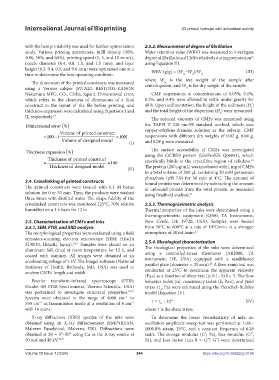Page 252 - IJB-10-1
P. 252
International Journal of Bioprinting 3D-printed hydrogel with antioxidant activity
with the best printability was used for further optimization 2.5.2. Measurement of degree of fibrillation
study. Various printing parameters, infill density (30%, Water retention value (WRV) was measured to investigate
40%, 50%, and 60%), printing speed (1, 5, and 10 mm/s), degree of fibrillation of CMFs relatively during preparation
21
nozzle diameter (0.4, 0.8, 1.0, and 1.5 mm), and layer using Equation III.
height (0.3, 0.4, 0.5, and 0.6 mm) were optimized one at a WRV (g/g) = (W −W )/W (III)
time to determine the best operating condition. w d d
where W is the wet weight of the sample after
The dimension of the printed constructs was measured w
using a Vernier caliper (PITA20, BESTOOL-KANON centrifugation, and W is the dry weight of the sample.
d
Nakamura MFG. CO., Chiba, Japan). Dimensional error, CMF suspensions at concentrations of 0.05%, 0.1%,
which refers to the closeness of dimensions of a final 0.2%, and 0.4% were allowed to settle under gravity for
construct to the layout of the file before printing, and 48 h. Upon sedimentation, the height of the sediment (H )
s
thickness expansion were calculated using Equations I and and the total height of the dispersion (H ) were measured.
o
II, respectively. 19 The reduced viscosity of CMFs was measured using
Dimensionalerror% () the TAPPI T 230 om-99 standard method, which uses
Volume of printedconstruct copper-ethylene-diamine solution as the solvent. CMF
= 100 ( ×100) suspensions with different dry weights of 0.02 g, 0.04 g,
−
Volume of deesignedmodel and 0.08 g were measured.
(I)
Thicknessexpansion % () The surface accessibility of CMFs was investigated
using the CtCBD3 protein (UniProKB: Q06851), which
Thicknessofprinted construct specifically binds to the crystalline region of cellulose.
21
= ×100
Thickness oof designed model The protein (200 µg/mL) was incubated with 1 mg of CMFs
(II)
in a total volume of 500 µL containing 50 mM potassium
phosphate (pH 7.0) for 30 min at 4°C. The amount of
2.4. Crosslinking of printed constructs bound protein was determined by subtracting the amount
The printed constructs were treated with 0.1 M borax of unbound protein from the total protein, as measured
solution for 0 or 30 min. Then, the products were washed using Bradford analysis. 22
three times with distilled water. The shape fidelity of the
crosslinked constructs was monitored (25°C, 70% relative 2.5.3. Thermogravimetric analysis
humidity) on a 3 h basis for 12 h. Thermal properties of the inks were determined using a
thermogravimetric equipment (Q500, TA Instruments,
2.5. Characterization of CMFs and inks New Castle, DE 19720, USA). Samples were heated
2.5.1. SEM, FTIR, and XRD analysis from 10°C to 600°C at a rate of 10°C/min in a nitrogen
The morphological properties were evaluated using a field atmosphere of 40 mL/min. 23
emission-scanning electron microscope (SEM; Hitachi 2.5.4. Rheological characterization
SU8030, Hitachi, Japan). 20,21 Samples were placed on an The rheological properties of the inks were determined
aluminum foil, dried at room temperature for 12 h, and using a controlled-stress rheometer (AR2000, TA
coated with osmium. All images were obtained at an instrument, DE, USA) equipped with a sandblasted
accelerating voltage of 5 kV. The ImageJ software (National parallel plate (diameter = 25 mm). A flow-ramp test was
24
Institutes of Health, Bethesda, MD, USA) was used to conducted at 25°C to determine the apparent viscosity
analyze CMFs’ length and width.
(Pa·s) as a function of shear rate (γ˙; 0.1–10.0 s ). The flow
−1
Fourier transform-infrared spectroscopy (FTIR; behavior index (n), consistency index (k; Pa·s), and yield
Nicolet iS5 FTIR Spectrometer, Thermo Scientific, USA) stress (τ ; Pa) were estimated using the Herschel–Bulkley
o
was performed to investigate structural properties. 20,21 model (Equation IV).
Spectra were obtained in the range of 4000 cm to n
−1
550 cm in transmission mode at a resolution of 4 cm τ = τ + kγ˙ (IV)
−1
−1
0
with 16 scans. where τ is the shear stress.
X-ray diffraction (XRD) spectra of the inks were To determine the linear viscoelasticity of inks, an
obtained using an X-ray diffractometer (EMPYREAN, oscillation amplitude sweep test was performed at 1.0%–
Malvern Panalytical, Malvern, UK). Diffractions were 1000.0% strain, 25°C, and a constant frequency of 6.28
obtained at 2θ = 5°–50° using Cu as the X-ray source at rad/s. The storage modulus (G¢; Pa), loss modulus (G²;
50 mA and 40 kV. 20,21 Pa), and loss factor (tan d = G²/ G¢) were determined
Volume 10 Issue 1 (2024) 244 https://doi.org/10.36922/ijb.0164

